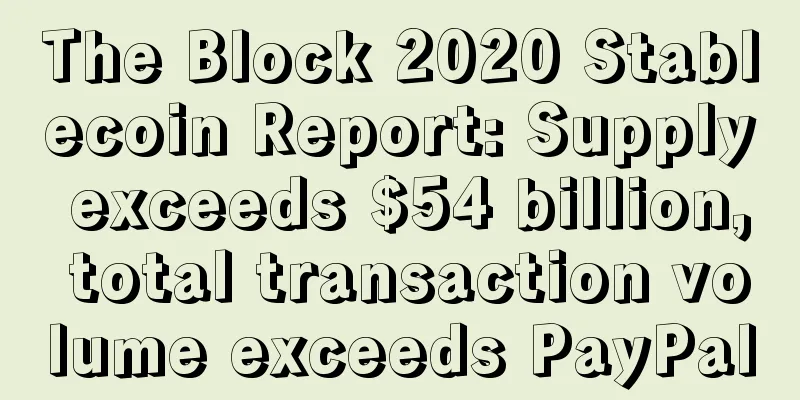The Block 2020 Stablecoin Report: Supply exceeds $54 billion, total transaction volume exceeds PayPal

|
By Larry Cermak, Head of Research at The Block Translation: Lu Jiangfei In the past year, the stablecoin market has achieved incredible growth, with the current supply exceeding $54 billion and the average monthly on-chain transaction volume reaching $380 billion. Recently, The Block released a 130-page stablecoin market report. The key content of the report is excerpted as follows: Since January 2020, many stablecoin business indicators have achieved huge growth, such as:
However, although various indicators have grown significantly, there are not enough products to support them. In fact, the main reasons for the surge in the stablecoin market last year are as follows:
In 2020, stablecoin transactions reached 110 million with a total transaction value of more than $1 trillion. In comparison, PayPal's transaction volume last year was 154 billion with a total transaction value of approximately $936 billion. From this we can clearly see the difference, in terms of the average transaction value, PayPal is about $60 per transaction, while stablecoins are more than $9,000. On the one hand, stablecoin transaction fees are indeed slightly higher; on the other hand, stablecoins do not have many other use cases (mainly trading) at present, so most stablecoin transactions are above $100. Among all stablecoin transactions, about 40% of the transaction amounts are between $100 and $1,000. At present, the cryptocurrency exchange Binance has the largest number of stablecoins. According to data at the end of January, the total amount of stablecoins held by Binance has reached nearly $10 billion. In addition, a large number of stablecoins are also locked in DeFi protocols such as Curve, Aave and Uniswap. About 40% of the stablecoin supply comes from exchanges, 11% comes from DeFi protocols, and the rest comes from wallets, OTC platforms, trading firms, etc. The following chart shows the geographical distribution of the two most popular stablecoins, USDT and USDC. USDT is most used in Asia, while USDC is most used in the United States. This is mainly because many Asian exchanges chose USDT stablecoin in the early days. The vast majority of stablecoins are pegged to fiat currencies and use fiat currencies as collateral, accounting for 96%. The reason for choosing to peg to fiat currencies is mainly because this method is the most scalable and the execution process is also very simple. As of the end of January, 70% of the stablecoin supply was on the Ethereum blockchain, 27% on the TRON blockchain, and another 3% on OMNI. There is a shocking data that currently 99% of the stablecoin supply is anchored to the US dollar. There are two main reasons for this: one is that traders still prefer the US dollar, and the other is that non-US dollar stablecoins are more difficult to cash out and the interest rate is relatively low. Tether is currently the most "market-dominant" stablecoin. Let's take a look at the relevant data:
|
<<: Data: 29% of British investors are encouraged to invest in Bitcoin by the bull market
Recommend
A woman with a hooked nose has a weak sense of affection
Most people's noses are different, and some p...
Men with droopy eyes often do ungrateful things
Is it good for a man to have droopy eyes? The dro...
What is the relationship between moles and destiny?
What is the relationship between moles and destin...
The nose bridge is bumpy and the face is irritable
In our daily lives, we always come into contact w...
Beauty peak analysis
A widow's peak refers to a point in the middl...
Bitcoin and the Death of the Dollar
There is a lot of talk about the US dollar losing...
[ChainDD Exclusive] The Ethereum community continues to split, and EIP-1559 cannot save the high GAS fee and network congestion
Author | Han Ling Source | Liandede It has been 1...
Operation DOGE: How Musk used an unofficial team to influence the White House
Musk is trying to run the White House the same wa...
What are nasolabial folds? What does the legal entry tell you?
The nasolabial folds refer to the two lines exten...
Is it good for a man to have a big mouth? He is more likely to attract villains.
In fact, there are so many people in the world, b...
Your mouth shows your fortune
Your mouth shows your fortune The mouth represent...
IPFS Weekly 93: A quick read of this week’s highlights
Welcome to IPFS Weekly The InterPlanetary File Sy...
London researchers explore blockchain applications beyond financial services
Rage Review : A research institute at Imperial Co...
What career is suitable for you?
We often hear people say that if someone is good-...
What are the characteristics of a woman with a crying face that will harm her husband?
Facial features have a very direct impact on the ...









